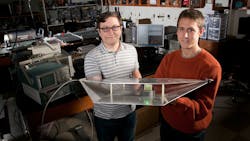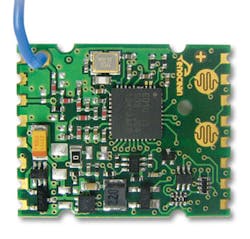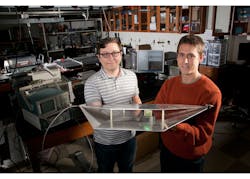This file type includes high-resolution graphics and schematics when applicable.
Microwave components and systems have long depended on developments within many different technology areas to sustain the evolution of the industry as a whole. Take gallium arsenide (GaAs). For many years, it was viewed as “the semiconductor technology of the future” for its capabilities in broadband, high-gain field-effect transistors (FETs). But because engineers by nature are always striving for better ways to do things, new technologies are constantly under the microscope.
Gallium nitride (GaN) is currently the industry’s “darling” semiconductor technology for a wide range of applications, from commercial through military uses and even emerging industrial RF energy applications in heating and cooking, to replacing one of the more time-honored of this industry’s technologies, the vacuum tube. It takes quite a few technologies to keep this industry going and growing. GaN represents just one of the many worth watching in the years ahead.
Dwindling bandwidth has been a consistent concern for wireless service providers, as they attempt to provide additional capacity for an increasing number of wireless subscribers. In addition, machines and things will be requiring bandwidth in growing numbers, with industrial applications embracing machine-to-machine (M2M) wireless connections to the Internet and Internet of Things (IoT) devices helping automate the world around us.
Higher in Frequency
New standards and specifications for fifth-generation (5G) cellular services hope to address limited bandwidth not only by investigating different multiplex and modulation formats, but also by exploring frequency spectra once considered out of reach for practical use: millimeter-wave frequencies of 30 GHz and higher. In recent years, for example, automobile manufacturers have been integrating forward- and reverse-looking radar systems designed as one or more integrated circuits (ICs) at 77 GHz and various other frequencies.
The challenge of emerging 5G cellular systems to manufacturers of millimeter-wave components will be whether they can produce these components less as specialty items for space and military applications and more as commodity items for commercial and industrial application. With the coming of 5G cellular systems throughout the next decade, it appears that opportunities will be many for practical millimeter-wave technology.
Some firms are well aware of the growing opportunities for applications at these higher frequencies and have gone about refining the technologies needed to make millimeter-wave devices more practical. A long-time supplier of precision millimeter-wave components, Spacek Labs, for instance, has been dedicated to supplying high-quality components for military and space-based systems. This includes its recently introduced model MVU-10 double-balanced mixer.
When fed with local-oscillator (LO) signals from 40 to 60 GHz, the mixer can convert RF signals from 50 to 75 GHz to an intermediate-frequency (IF) range of dc to 20 GHz with 7-dB typical conversion loss. It is built for reliability, with waveguide flanges for the millimeter-wave ports, but admittedly larger than an integrated-circuit (IC) solution. The expansion of millimeter-wave technologies into commercial markets will require smaller, lower-cost components.
A step in this direction is being taken by Anokiwave. The firm has applied extensive experience in semiconductor device design and development, and works with outside semiconductor foundries to create radio and amplifier ICs for radar and communications systems at RF through millimeter-wave frequencies. The firm’s use of on-chip, active electronically steerable antenna (AESA) structures has made possible complex radio front-end designs for receive and transmit functions in devices small enough to fit in SMT packages.
An example of what’s possible with silicon-germanium (SiGe) semiconductor materials can be seen in Anokiwave’s AWS-0102 quad-core satcom receiver IC, which is intended for K-band use from 17.7 to 20.2 GHz. It incorporates an intelligent blend of digital and analog circuitry to include 5-b phase control and the ability to achieve right-handed circular polarization (RHCP) and left-handed circular polarization (LHCP).
At millimeter-wave frequencies, the company’s model AWP-7176 is a five-stage power amplifier for use from 71 to 77 GHz. It is fabricated on a 0.1-µm pseudomorphic-high-electron-mobility-transistor (pHEMT) semiconductor process and achieves 26-dB gain. The chip even includes a forward power detector to reduce the need of adding a component to a system design.
Harvesting Energy
Lots of publicity lately has been given to the market potential for IoT devices over the next decade, and how all of these Internet-connected “things” will enhance quality of life. Though this may hold up as true, these things will also significantly contribute to the enormous amount of data that must be transferred to the Internet, mainly through wireless means like wireless sensor networks (WSNs). That will eventually mean furnishing billions of electronic sensors and other devices with a source of power.
Possible solutions to the growing power drain include creating more energy-efficient IoT circuits, or even finding ways to recapture or reuse energy from an electronic device or other nearby energy sources (e.g., optical or thermal energy). Some firms, such as Linear Technology, have already made great strides in energy management and reuse technologies with energy-harvesting ICs that can convert vibration, thermal energy, or solar energy into electricity. One example is Linear’s LTC3107 dc-dc converter, which is designed to extend the battery life in a low-power wireless device. The converter, which provides +2.2-V dc output, automatically shifts from running on battery power to using harvested power whenever it is available from a thermal source.
Energy-harvesting circuits are actually subsystems, with antenna, RC-to-dc conversion, energy storage, sensors, and microcontroller to balance charging and discharging of energy. Among the companies at the forefront of developing energy-harvesting solutions is EnOcean. Its full lines of circuits and modules for capturing and transferring energy, which include transmitters, sensors, and receivers, can be used at standard frequencies around the world. For instance, the model PTM 33x transmitter module (Fig. 1), with variants at 315, 868, and 902 MHz, permits the use of wireless sensors and other electronic devices without batteries. The module can be equipped with a whip antenna or used with an external antenna.
Companies like Powercast Corp. have made significant progress on wireless transfer of power. The firm developed components for sending power to battery-free wireless sensors using its Powercaster transmitter to sense energy by means of direct-sequence spread spectrum (DSSS) modulation (at a center frequency of 915 MHz) to a model P2110 Powerharvester receiver. The receiving antenna is a low-cost, printed-circuit directional design with gain of 6.1 dB fabricated on FR4 circuit material.
By transferring energy from the transmitter to the receiver and the sensors it powers, it is possible to achieve a WSN without batteries in each sensor. The next step in the technology evolution will be for each sensor to recapture enough energy from the environment to be self-powered.
Energy harvesting is certainly not a mature technology, but much research is being directed at improving the technology in conjunction with metamaterials or composite materials. For example, more than three years ago, students at Duke University demonstrated how metamaterials could be used to form a power-harvesting cell capable of harvesting enough excess environmental microwave energy into the 7.3 V dc needed to power a light-emitting diode (Fig. 2).
Georgia Tech’s Strategic Energy Institute has put a great deal of effort into methods for recovering energy, including a two-stage power-management and storage system that can harvest energy from human motions, such as walking. The system is based on a capacitor for energy storage, a power-management circuit, and a larger capacitor or battery for more long-term energy storage. For instance, a triboelectric generator embedded in a shoe would produce electricity as a person walked, and the energy would subsequently be stored and consumed as needed.
Success in energy harvesting depends heavily on the efficiency of rectifying antennas and finding suitable substrate materials. Current research has included metamaterials and even paper as antenna substrates. Metamaterials show great promise as microwave absorbers—they have been used in pyramidal structures as broadband absorbers, achieving as much as 90% absorption over broad frequency ranges.
Looking for parts? Go to SourceESB.
About the Author
Jack Browne
Technical Contributor
Jack Browne, Technical Contributor, has worked in technical publishing for over 30 years. He managed the content and production of three technical journals while at the American Institute of Physics, including Medical Physics and the Journal of Vacuum Science & Technology. He has been a Publisher and Editor for Penton Media, started the firm’s Wireless Symposium & Exhibition trade show in 1993, and currently serves as Technical Contributor for that company's Microwaves & RF magazine. Browne, who holds a BS in Mathematics from City College of New York and BA degrees in English and Philosophy from Fordham University, is a member of the IEEE.



